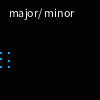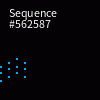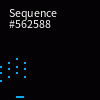08-11-2017, 12:45 AM
another tutorial by phiot (jonah). its about complex bass lines and chord progressions. in the first post I'm going to talk about what a bass line is, what a chord progression is, and why they're essential to music.
First off, what is a chord proggression? you hear about them frequently, im guessing. Well, a chord is "three or more notes that combine harmoniously". simple as that. a typical chord you'll see is a major/minor triad. <--- first one is major, second one is minor. Those are basically the simplest chords you can get. you can get more complexed, but lets save that for later. A chord PROGRESSION is just what it sounds like. a progression throughout multiple chords. (hope im not getting that definition wrong). Heres the one you hear infinity times in modern pop (looking at you chainsmokers)
<--- first one is major, second one is minor. Those are basically the simplest chords you can get. you can get more complexed, but lets save that for later. A chord PROGRESSION is just what it sounds like. a progression throughout multiple chords. (hope im not getting that definition wrong). Heres the one you hear infinity times in modern pop (looking at you chainsmokers)  . Chord progressions set the mood of the music. Film scorers use them to convey emotions to the viewers. Most of all, music is unbearable without them.
. Chord progressions set the mood of the music. Film scorers use them to convey emotions to the viewers. Most of all, music is unbearable without them.
Now, whats a bassline? a bassline is even simpler. its typically just one note at a time, since bass becomes terrible when it isnt just one note (an opinion). It usually follows the chord progression ( ) but it doesn't need to. you REALLY want it to harmonize with the above notes though, especially the lower the bass is. Not all genres use a bass line, but most modern ones do. You might be able to get away with not using one, depending on your genre.
) but it doesn't need to. you REALLY want it to harmonize with the above notes though, especially the lower the bass is. Not all genres use a bass line, but most modern ones do. You might be able to get away with not using one, depending on your genre.
continued... (please dont post until its finished, ill need more posts.)
First off, what is a chord proggression? you hear about them frequently, im guessing. Well, a chord is "three or more notes that combine harmoniously". simple as that. a typical chord you'll see is a major/minor triad.
Now, whats a bassline? a bassline is even simpler. its typically just one note at a time, since bass becomes terrible when it isnt just one note (an opinion). It usually follows the chord progression (
continued... (please dont post until its finished, ill need more posts.)